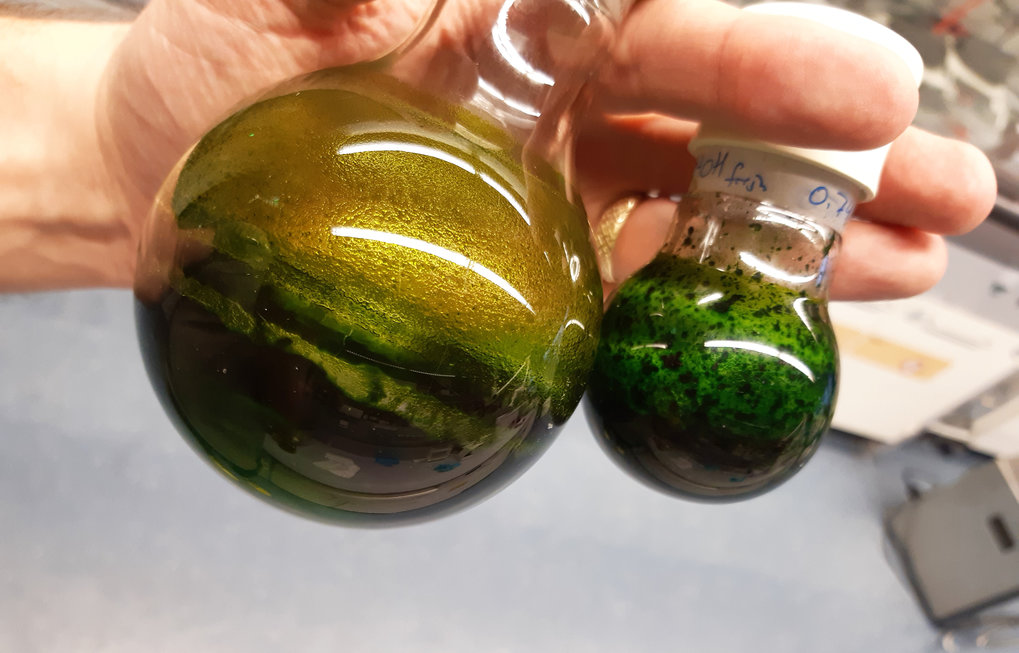AKTUELL!
Artemisia annua to be tested against COVID-19
Artemisia annua extracts:
 The Max Planck Institute of Colloids and
Interfaces, Potsdam (Germany) will collaborate with ArtemiLife Inc., a
US based company and medical researchers in Denmark and Germany to test
Artemisia annua plant extract and artemisinin derivatives in laboratory
cell studies against the novel coronavirus disease (COVID-19). April 08, 2020
The Max Planck Institute of Colloids and
Interfaces, Potsdam (Germany) will collaborate with ArtemiLife Inc., a
US based company and medical researchers in Denmark and Germany to test
Artemisia annua plant extract and artemisinin derivatives in laboratory
cell studies against the novel coronavirus disease (COVID-19). April 08, 2020COVID-19 is caused by severe acute respiratory syndrome coronavirus-2 (SARS-CoV-2), a positive-sense single-stranded RNA virus that is contagious in humans. Like the SARS-related coronavirus strain implicated in the early 2000’s SARS outbreak, SARS-CoV-2 is a member of the same subgenus. SARS-CoV-2 is unique among known beta-coronaviruses in its incorporation of a polybasic cleavage site, a characteristic known to increase pathogenicity and transmissibility in other viruses.
“Given the similarities between those two viruses, plant extracts and artemisinin derivatives need to be tested against the new coronavirus and this international collaboration makes it possible,” continued Prof. Seeberger.
 |
| Adam Maust in Artemisia annua field |
Adam Maust in Artemisia annua fields - ArtemiLife Inc. CEO
ArtemiLife Inc., a US based company, is providing the necessary plant material for the studies. "We've been studying Artemisia annua and cultivating our fields with agriculture experts in Kentucky over the past few years. We’re privileged to have the opportunity to collaborate with the Max Planck Institute of Colloids and Interfaces in these studies," said Adam J. Maust, ArtemiLife Inc. CEO.Max Planck Institute for Colloids and Interfaces
The Max Planck Institute of Colloids and Interfaces was founded in 1992 and is divided into four departments (Biomaterials, Biomolecular Systems, Colloid Chemistry, Theory & Bio-Systems). Current research topics include polymeric films, membranes, organic and inorganic nanostructures, microcapsules, biomineralization, nano- and microreactors, molecular motors and filaments, and the chemistry and biology of carbohydrates. The Biomolecular Systems Department has been studying, inter alia, the production and use of artemisinin and its derivatives for almost a decade.
https://www.mpikg.mpg.de/en
ArtemiLife Inc.
ArtemiLife Inc. is developing and planning to commercialize Artemisia annua-based products. ArtemiLife Inc. blends cutting edge science with pesticide-free growing and US-based production techniques, ArtemiLife Inc. is launching a range of teas and coffees supplemented with Artemisia annua.
https://artemilife.com/
Apotheke adhoc: Es ist ein Kraut gewachsen...
Beifuß gegen Covid-19 - Alexandra Negt,
14.07.2020 08:09 Uhr
LINK: Forscher des Max-Planck-Instituts haben den Arzneistoff Artemisinin
auf eine Wirksamkeit gegen Sars-CoV-2 untersucht.
Artemisia annua in Labortests gegen das Coronavirus
Pflanzenextrakte werden in Studien an Zellkulturen auf ihre Wirksamkeit gegen Sars-CoV-2 untersucht
14. April 2020
Laborstudien an Zellen sollen Hinweise liefern, ob sich Extrakte aus dem einjährigen Beifuß (Artemisia annua)
oder Derivate von Artemisinin, das aus der Pflanze gewonnen wird, als
Wirkstoff gegen das neuartige Coronavirus SARS-CoV-2 eignen könnte. Die
Untersuchungen nimmt ein Team des Max-Planck-Instituts für Kolloid- und
Grenzflächenforschung in Potsdam gemeinsam mit dem US-Unternehmen
ArtemiLife Inc. und medizinischen Forscherinnen und Forschern in
Dänemark und Deutschland vor.
http://www.mpikg.mpg.de/6309428/news_publication_14825271_transferred?c=44858
http://www.mpikg.mpg.de/6309428/news_publication_14825271_transferred?c=44858
Krebszellenaktivität kann in vielen Fällen gestoppt werden:
Die über 245 Wirkstoffe* von "Artemisia annua", aus dem das Malariamittel Artemisinin gewonnen wird, haben laut zahlreicher Studien diese Ergebnisse gezeigt:
 |
| Artemisia annua Hybridzüchtung A3 mit 20-fachem Artemisiningehalt - Testanbau im Garten |
 |
| aus 25 Pflanzen in der ersten Saison 420 g geerntet - Pulver des getrockneten, feingemahlenen Krautes |
- Die Wirkstoffe sind besonders unter Eisen-II Gabe hochselektiv und wirken auf Krebszellen sehr toxisch; sie greifen Erbgut und Zellmembran der Krebszellen an.
- In vitro - Apoptose von Krebszellen innerhalb 16 Stunden bis zu 97%
- Auf normale Zellen haben sie bei korrekter Verwendung fast keinen negativen Effekt.
- Auch Krebszellen, die gegenüber chemischen Zytostatika resistent sind, reagieren bzw. werden häufig abgetötet.
- Hemmung der Angiogenese - tumoreigenes Blutversorgungssystem
- Verringerung der Tumorgröße
- Sehr viele Krebsarten und Zelllinien reagieren und sind empfindlich!
- Die Wirkstoffe erhöhen oder stellen die Sensitivität gegenüber radiologischer Behandlung wieder her.
- Das Phytozytostatikum "Artemisia annua" verträgt sich mit den meisten Chemozytostatika und unterstützt deren Wirkung, aber nicht mit allen; bitte vorher klären!
- Der Hauptwirkstoff Artemisinin gilt als so gut wie nicht wasserlöslich und muss deshalb per Alkohol, DMSO, Hexan oder anderen Lösungsmitteln aus den Pflanzenzellen extrahiert werden, um an den FeII Atomen innerhalb der Ca-Zellen andocken und dort seine extrem oxidierende Wirkung entfalten zu können! Durch den Einsatz von DMSO sind die Extrakte seit einiger Zeit verschreibungs-, d.h. rezeptpflichtig!
- Wenn der Wunsch nach einer sehr schnell wirksamen Therapie auf Basis von Artemisia annua besteht, bitte unter Menüpunkt "Bezugsquellen" bei den Extrakten nachschauen!
- Verbesserung der Langzeitwirkung lag bei 60%, in vitro 100% Henry Lai, Narendra Singh, Washington University, 2002
Sesquiterpenlacton Artemisinin (Qinghaosu)
Sesquiterpenderivate wie z. B. die Arteannuinsäure kommen in
Arteannuin B vor, bei denen es sich evtl. um Vorstufen in der Biogenese des Artemisinins handelt
Dihydroartemisinin
Artesunat (12a-Succinat von Artemisinin)
Artemether
Arteether
Sesquiterpenlactone (Dihydro-epideoxyarteannuin B und Deoxyartemisinin)
Sonstige Verbindungen:
methoxylierte Flavonoide = Artemetin, Chrysosplenetin oder Eupatorin
Cumarin, Menthol, Thymol, Beta-Sitosterol
Wirkungsmechanismus von Artemisia
Der Wirkungsmechanismus ist äußerst bemerkenswert. Artemisia annua enthält ein chemisch stabiles Peroxid, was es nach den chemischen Grundregeln gar nicht geben kann. Plasmodien und auch Krebszellen enthalten 10-1000 mal mehr Eisenionen im Vergleich zu normalen Zellen. Dieses Eisen „zerbricht“ das Peroxid, welches sich sofort in zwei sehr aggressive freie Radikale verwandelt und die betroffene Zelle rasch abtötet. Einfach ausgedrückt: die Krebszelle wird von innen her massiv oxidiert und stirbt. Grundsätzlich kann jede Krebsart mit Artemisia annua behandelt werden, sehr langsam wachsende Krebszellen mit geringem Eisengehalt werden ev. nur mäßig oder kaum angegriffen.
Biologische Chemotherapie






